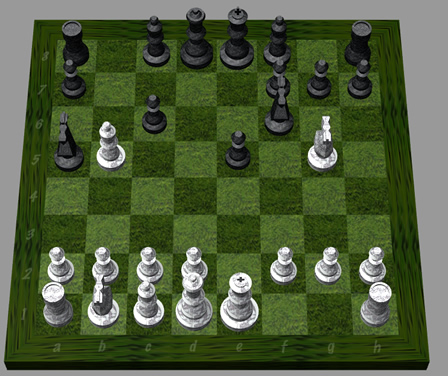
Games come in several basic categories of interaction. Some games are played solo, some with 1 or more partners and some in competition with one or more groups. In order for game play to be successful its users must be socialized to the degree that they know anti-social behavior will end the game or at least others will leave. That is, games reinforce the need for social skills and the value of others.
Some games come built in to the computer. Others can be found online or can be purchased and installed. The Internet arena adds certain new characteristics to game play, including the ability to play a game live with others between any two or more points on the globe and include an audience. Digital games also begin to teach us about basic characteristics of the computers that play and manage the games. Let's try some introductory experiments that will also teach us about Web conferencing software, another form of digital interaction.

A Chess game called Chess Titans is included in Windows Vista and Windows 7 (in more advanced versions of the OS). The game of Chess also comes for free with the Macintosh operating system. To find the game on your Mac, click the hard drive symbol on the desktop, open the Application folder and double-click on the application called Chess. Next, select Game, then New and make some decisions. Though it is possible to play human against the computer at different degrees of difficulty, set the Players choice to Human vs. Human. Use the Preferences command under File allows changes to the look of the board and its pieces. The above picture shows marble pieces playing on a grass covered board.
Here are some "ice-breaker" options for Web conferencing interaction that your instructor may require:
How might the capacity just demonstrated be used instructionally in classrooms?
Find a partner to share with from your classmates and select a date in the next 2 weeks in which you will practice Web conferencing between your two school classrooms after school. How well does the audio and screen sharing work? Can you hear each other with ease? Does the network slow down the screen interaction or does it work well enough? Use the archiving button to record the last 60 seconds of your testing in which you review how well things are working. As soon as you have the file archived from your mutual discussion, upload the file in the School Based Web Conference Test 1 assignment link in Blackboard. If you do not have a projection system or interactive whiteboard in your classroom, please see your instructor for options. Do see your instructor for the calendar deadline in posting the archive of your web conferencing session.
Also, begin to plan your first lesson or activity that you will co-teach with your partner's classroom. If you have an interactive whiteboard, get to know how that software operates by finding the tutorials for it in Atomic Learning (whose link is in Blackboard). You will want to begin to use it when you co-teach and this will take some practice.
The chapter parent page to this page on 21st Century Games and Interaction - Houghton updated May 11, 2013